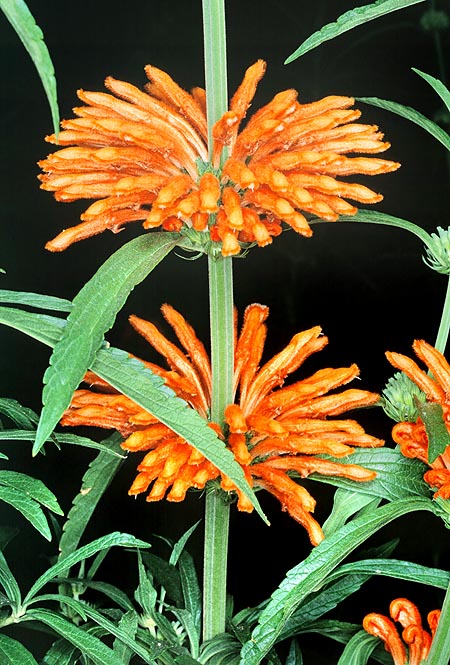Family : Lamiaceae

Text © Pietro Puccio

English translation by Mario Beltramini

Nice and easy to grow, the Leonotis leonurus has also medicinal virtues © Mazza
The name of the genus is the combination of the Greek words “léon” = lion, and “ôtos” = ear, due to the down on the upper lip of the flower which makes it look like the ear of a lion; the name of the species is the combination of the Greek words “léon” = lion, and “ourā” = tail, with reference to the tail which might recall the tail of a lion.
Common names: lion’s-ear, lion’s tail, lion’s claw, minaret flower, wild dagga (English); leonotis (Italian); oreille de lion, queue de lion (French); orelhas-de-leão, rabo-de-leão (Portuguese); cola de león, oreja de león (Spanish); Löwenohr, Löwenschwanz (German).
The Leonotis leonurus (L.) R.Br. (1811) is an evergreen perennial, or semi-evergreen, bush with woody base from which depart erect herbaceous stems with quadrangular section, not ramified, covered by a slight down, up to about 2 m tall.
The leaves are opposite, linear or lanceolate, 5-10 cm long and 1-2 cm broad, of a matt green colour with margins irregularly crenulated-serrate in the upper half. The inflorescences are erect with several tubular, 5 cm long, flowers of orange colour and covered externally by a thick down having the same colour, placed in false verticils which form each other in succession, around the nodes, in autumn; there are also varieties of white, apricot and red colour.
The fruit is the typical one of the Lamiaceae, subdivided when ripe in four brown, 6 mm long, achenes (one-seeded indehiscent dry fruits). In summer, it reproduces by seed, cutting, also in water, and by division; it easily self-disseminates.
It is a species of remarkable ornamental value and easy to cultivate; it requires full sun, or, at most, a slight shade, and regular, but spaced in time summer watering, in order to allow the soil to dry up and it may resist also to long periods of dryness; Not particular about the soil, even if poor, provided well drained, as it does not bear the water stagnations which may cause deadly rottenness. It resists to the high temperatures as well as to the relatively low ones, when around the 0 °C the aerial part gets damaged, but the woody base may resist to the -5 °C and resume vegetating in spring. Furthermore, it has a fairly good resistance to the saltiness and may be then also employed in gardens close to the sea.
In order to encourage tillering it is good to do a low pruning, by the end of the blooming or by the beginning of spring. Where the climate does not allow the permanent cultivation in open air, it may be employed as annual, seen its fast growth, sowing in winter in a protected location and planting by early spring. It is cultivable also in pot for the decoration of patios, terraces, greenhouses and luminous verandas in a rich substratum, well draining, to be regularly watered in summer, moderately in winter and with periodical fertilizations rich in phosphorus; it has also a limited use as cut flower.
Stems and leaves are variously and widely utilized, due to their anti-inflammatory properties, in the traditional medicine, against fever, cephalalgies, cough and other pathologies like dysentery and asthma; the most important active principles contained are the leonurine and the marrubiine, as well as tannins and saponins.
Synonyms: Phlomis leonurus L. (1753); Leonurus africanus Mill. (1768); Leonurus superbus Medik. (1784); Leonurus grandiflorus Moench (1794); Phlomis speciosa Salisb. (1796); Hemisodon leonurus (L.) Raf. (1837).
→ To appreciate the biodiversity within the family LAMIACEAE please click here.
